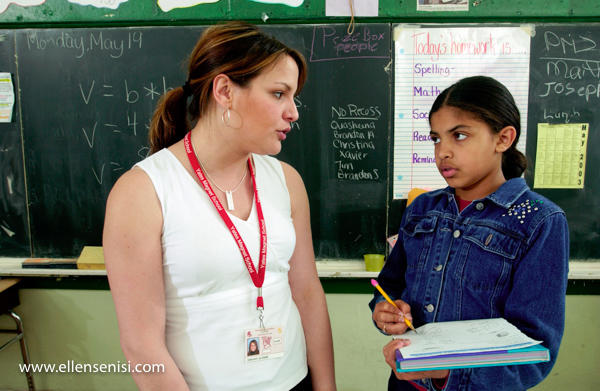
“Ideally, students are in a flow state, a place where they’re so interested in what they’re doing that they lose track of time,” says Vicki Davis. “Or at least that’s what we shoot for, but the reality is you’re not consistently going to have a classroom of fully engaged students. There are varying levels of interest, depending on the subject you’re covering, and some students are going to find it easier to get on board than others.”
Excitement Is Not a Pre-requisite for Engagement
But even without full engagement, you can help students move forward. Davis, who teaches at Westwood Schools in Camilla, Georgia, makes a distinction between engagement and excitement. “You don‘t have to be excited about a subject to be engaged in learning,” she says. “I think we have to set ourselves up with realistic expectations. Kids get bored; they always have, but we can still make forward progress.”
And that forward progress is engaging in its own way. Seeing that they’re having some success, students are more willing to engage, and their interest becomes more piqued.
Both student and teacher have critical roles in feeding engagement. Davis offers three key practices to help teachers create the conditions where students can more easily engage, and both teacher and student can work together in the aim of forward progress:
1. Have a relationship with each student.
It’s hard to engage with and learn from someone you don’t like. On Davis’s blog, her post Ten Ways to Flip a Kid and Turn Their Day Around lists actions that require little time but make a big difference in how accepted and cared for a child feels in the classroom. Quoting Kevin Honeycutt, she says one way to reach a child is by “rebelieving” in her. “Give the child another chance. Decide you’re going to rebelieve in her, and show it with your actions. It can be hard, but it is necessary,” she says.
Other actions that help “flip a kid” and support good teacher-student relationships include “stand there and care” as children enter the classroom and talk privately with students who act out.
“Pull up a chair” is one Vicki uses when students are working on a project. Her chair is on wheels and she rolls around the room, sitting beside students at their tables to find out how they’re doing. “I spend a moment with each student,” she says. “I want to be at eye-level with them to reinforce that we’re collaborating, not that I’m telling them what to do. Telling them doesn’t help. Learning isn’t something you do to someone. It’s something we’re both involved in. I’m helping them engage in the learning process.”
2. Have Routines and Procedures
While monotony in the learning process kills engagement, it’s important to stay consistent with routines and procedures. Davis says, “Students want to be clear, ‘this is how I turn in my work and this is how I get it back.’ They get frustrated when they’re always turning in things in different ways. Set up your room so there’s a consistent location for them to submit work and receive feedback on it.”
3. Reflect as You Teach
“Student engagement happens when the teacher is engaged,” Davis says. Teachers can get themselves more engaged by finding out what students like and dislike and tweaking activities and plans as needed. She suggests reflecting on each lesson and thinking about how teacher and students could work better together to improve the learning process.
Formative assessment is a vital tool for understanding in real time if students are actually learning (vs. summative assessment which is a traditional test, given at the end of a unit). Knowing who needs remediation before a post-unit quiz allows teachers to address that need immediately.
Davis became completely committed to formative assessment when she was teaching binary numbers, her hardest topic of the year.
After working on some examples with her class, two students said they understood and were ready to move on. She asked the rest of the class if they were ready, and all enthusiastically nodded. To test their progress, she wrote a problem on the board. Students were already logged into [formative assessment tool] Socrative, and a box opened up on their screens. Each student typed in his or her answer to the problem. They clicked enter, and all of their answers appeared on her screen beside the name of each student.
In fact, only the two students who had spoken up solved the problem correctly.
Davis says, “I thought I knew my students well enough to read their body language, but I was wrong. ...What I learned [from that experiment] forever changed my views on being a better teacher.”
Assessing students as you go further enhances student engagement as they see that the teacher is going to know if they know the material right away. “I have students who can’t even think forward to tonight – they’re just too young – so a quiz in three days doesn’t motivate them. But with formative assessment, they know they can’t hide, and I don’t mean that in a punitive way. They’re more engaged because they know paying attention really does matter right now, at this moment.”
Teacher Engagement is as Important to the Learning Process as Student Engagement
Davis stresses the need for a supportive professional environment where teachers work and learn together to become better teachers. Citing research by Matthew Kraft, she says this is key to ongoing improvement. “It’s common for teachers to level off in their professional development after five years on the job. To keep learning and developing, teachers need to work with others, to collaborate. I think it’s a critical point that you need other people to keep improving.”
About Vicki Davis: A full-time teacher of 8th-10th graders at Westwood Schools in Camilla, Georgia, Davis also serves the school as IT director. She blogs at the popular Cool Cat Teacher Blog and made Mashable's Top 10 list of "Teacher Rock Stars on Twitter" in 2014. She also writes for Edutopia and her local newspaper. She hosts the bi-weekly "Every Classroom Matters" show on the BAM Radio Network which frequently trends in the top 10 in K12 Podcasts on iTunes. She frequently presents at online conferences and at face to face conferences (when her full time teaching schedule allows), including more than 20 keynotes including Google Teacher Academy, CUE, MACUL, IL-TCE, Conference for Media Organizations of Georgia and many more. She is a member of ISTE, CSTA, a Google Certified Teacher, and Discovery STAR educator.

